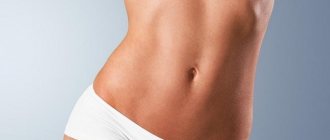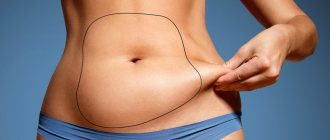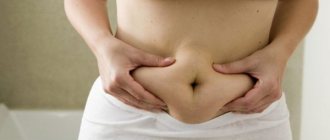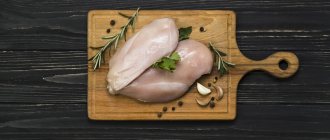Fat deposits in the abdominal area are very dangerous to health. Excess weight can provoke the development of serious diseases: metabolic syndrome, type II diabetes mellitus, heart pathologies, malignant tumors.
To define abdominal fat, localized in the abdominal cavity, around the internal organs, the term “visceral fat” is used. It can form in the area of the liver, kidneys, digestive organs, displace the diaphragm, and compress blood vessels.
Sometimes it happens that a person has excess deposits around the abdomen, but the overall weight remains within normal limits. This state of affairs cannot be considered safe. All unfavorable risk factors for excess fat remain.
There are 12 things that make you gain weight.
- Instead of a conclusion
Sweet foods and drinks
Most people consume a lot more sugar every day than they realize. Foods high in sugar include candy, cakes, carbonated drinks, flavored coffee, and sweet tea. Even “healthier” foods like muffins and frozen yogurt are potentially dangerous.
Clinical observations have shown a relationship between excessive sugar consumption and the formation of fat deposits. This is due to the high fructose content in dietary sugars. Common sugar and corn syrup are high in fructose. Sugar is a disaccharide consisting of 50% glucose and 50% fructose. Corn syrup contains 55% fructose.
In one study, overweight subjects consumed 25% of their daily calories from fructose-containing drinks for 10 weeks while following a weight loss diet. The results showed decreased insulin sensitivity and increased abdominal fat. [1]
The results of the second experiment with similar diet conditions, high in fructose, showed inhibition of metabolic processes in the subjects’ bodies and a decrease in fat burning. [2]
Sugar in any form poses a danger to the formation of extra pounds. The biggest problem is soda and other sugar-sweetened drinks. This is due to the fact that the body receives large amounts of sugar in a short time.
Dietitians say that liquid calories do not suppress appetite as much as calories from solid foods. High-calorie drinks do not make you feel full. When drinking these types of drinks, the body requires more food to satisfy hunger.
Frequent consumption of drinks, foods, and corn syrup with a high content of glucose and fructose leads to the formation of fatty deposits in the abdominal area.
Milk and dairy products
Photo by Anita Jankovic / Unsplash
If you are lactose intolerant, milk and dairy products cause increased gas formation with an unpleasant odor. Lactose is a sugar found in milk, and the enzyme lactase is responsible for its breakdown.
When the body does not produce enough lactase, dairy products can cause diarrhea, abdominal pain, and severe flatulence within 30 minutes to two hours after consumption.
Flatulence is bloating due to the accumulation of gases.
Probiotic gut bacteria like Lactobacillus are able to process and absorb lactose. Their high levels in the microbiota may reduce symptoms of intolerance, especially in people whose diets are high in galactooligosaccharides (GOS).
Alcohol
Alcohol has both positive and negative effects on the organs and systems of the human body. For example, judicious consumption of red wine reduces the likelihood of developing heart disease and stroke. Large amounts of alcohol lead to inflammatory liver diseases and other pathologies of internal organs.
Research suggests that alcoholic drinks not only inhibit fat-burning mechanisms. Alcohol calories are converted into fat and stored in the waist area—hence the term “beer belly.” [3]
One experiment found that men who drink large amounts of alcohol have 80% more problems with being overweight than men who don't drink. [4]
The amount of alcohol you drink during the day is of great importance. The subjects who drank one glass of alcoholic beverage (about 250 ml) had the least amount of abdominal fat. When drinking alcohol 4 or more times more, the risk of weight gain increases.
Drinking large amounts of alcohol increases the likelihood of developing diseases associated with excess abdominal fat.
How to remove sides for a man
The stronger sex has its own nuances.
- Men are more likely than women to drink alcohol. A couple of “legal” glasses of beer after a hard day at work is the norm for many, which is not even considered a health threat. But alcohol is not only high in calories in itself, but also slows down your metabolism. With it, even healthy food turns into fat deposits. A “beer belly” appears and, as its continuation, overhanging sides. To reduce your waist size, you need to completely eliminate alcohol.
- Another harmful male habit is an addiction to junk food and a lukewarm attitude towards healthy foods. Instead of boiled, baked and steamed, men prefer fried, smoked, salted. Instead of cereals and vegetables - fast food. A prerequisite for losing weight is to eliminate all these food waste from the diet.
- A man's daily intake of food energy should be reduced to an average of 2000 kcal. You can raise the bar higher in case of heavy physical activity.
- The water consumption rate is at least 2.5 liters per day. But it all depends on weight. If a man weighs under 100 kg, then his norm is 3 liters and above.
Otherwise, you should stick to the basic course: move a lot, do local exercises and self-massage, increase blood circulation with baths, turpentine baths, and wraps.
Yes, yes, I rubbed my stomach and sides, applied some shock mixture to them (for example, mustard powder with clay and cosmetic oil), wrapped myself in film, covered myself with a blanket, lay down for half an hour, washed everything off myself and then took a turpentine bath. How do you like this alternative to beer evenings? A bit boring? Add something interesting to the ritual: a movie, music, a book. And in the morning you will be like a cucumber. Fresh head, vigorous body.
Trans fats
Trans fats are a type of saturated fat that is one of the most harmful food components. For greater stabilization, hydrogen molecules are added to the molecules of unsaturated fats. This modification is used to increase the shelf life of products in factory packaging: muffins, crackers, baking mixes.
Trans fat content per 100 g of product:
| Product | Trans fat content |
| Confectionery fat | 10—33 g |
| Margarine | 0.2-26 g |
| Butter | 2-7 g |
| Whole milk | 0.07—0.1 g |
| Bread/Cakes | 0.1-10 g |
| Cookies and crackers | 1-8 g |
| Salty snacks | 0—4 g |
| Icing and candy | 0.1-7 g |
| Animal fat | 0—5 g |
| Ground beef | 1 g |
When studying the effect of trans fats on the human body, it was found that they provoke inflammatory processes. Excessive consumption of foods containing trans fats leads to insulin resistance, progression of cardiovascular disorders, and some somatic diseases.
Animal experiments have shown that eating a diet high in trans fats leads to excess body fat. For six years, monkeys were offered foods containing saturated fats. As a result, they gained 33% more visceral fat than those fed a monounsaturated fat diet. [5]
Consuming trans fats stimulates inflammation, which can cause insulin resistance and storage of belly fat.
What causes belly fat to grow?
Eating foods that contribute to the accumulation of fat deposits on the abdomen, sides, and lower back is not the only reason for the appearance of fat in the waist area.
The belly of women and men grows for different reasons and not in the same way. There are two types of fat deposits - deep or visceral fat, and superficial, subcutaneous fat. Deep fat is deposited on the internal organs of the abdominal cavity due to metabolic disorders or hormonal changes. In women, this can occur during or after pregnancy, menopause, in men - after the age of thirty. Nutrition has virtually no effect on these processes; it is difficult to fight visceral fat deposits - this requires a lot of time and significant efforts to change your lifestyle.
The appearance of subcutaneous fat occurs due to an excess of carbohydrates and fats in the diet, increased calorie content of the daily menu, its imbalance, and other violations of the principles of proper nutrition. By understanding what foods make your belly and sides grow, you can limit their consumption, thereby stopping the process of accumulating surface fats and starting the process of losing weight.
Simple carbohydrates in the diet
Carbohydrates are a key source of energy and are found in almost all foods, including dairy products, vegetables and fruits. The percentage of carbohydrates in the European diet is slightly more than 50% of all substances entering the body with food. Depending on the speed of breakdown and conversion of sugar into glucose, they are divided into simple, or fast, and complex, or slow.
You cannot completely eliminate carbohydrates from your daily menu - you will have to eat only certain types of greens. A diet for belly fat involves limiting the consumption of fast carbohydrates, which are found in:
- flour products;
- baking;
- sugar;
- some cereals;
- pasta;
- potatoes;
- bananas;
- dates;
- grapes;
- sweet soda.
After you eat one of these foods, your blood sugar levels rise quickly, but fall just as quickly, causing you to feel hungry. Slow carbohydrates take a long time to break down, glucose levels rise gradually, so you feel a surge of energy, and the feeling of fullness lasts for several hours. The proportion of simple and complex carbohydrates in a properly selected diet should be 1:3.
Consumption of animal fats
When considering the question of what foods make women's bellies grow, we need to mention animal saturated fats. Their excess can lead to a number of metabolic disorders, disruptions in the functioning of the cardiovascular system, high cholesterol levels, and other consequences that threaten your health and life. Products high in animal fats:
- butter;
- salo;
- fatty meats;
- fatty cheeses.
It is impossible to completely abandon animal fats for a number of reasons. They are involved in the absorption of a number of vitamins, influence the production of a number of hormones, and a third of all the cells of our body consist of them. During the diet, replace the above products with others that also contain animal fat, but in smaller quantities:
- low-fat dairy;
- eggs;
- fish;
- poultry meat;
- lean beef;
- rabbit meat;
- low-fat seafood.
Salty food
During any diet, it is often recommended to avoid salt. The calorie content of a dish does not increase when salt is added; another problem arises - fluid retention in the body. When we overuse salty foods, we experience increased thirst, which is precisely a signal about the beginning of this process. When fluids stagnate, metabolism and the removal of waste and toxins from the body slow down, you lose weight more slowly or not at all. Eliminate smoked foods and pickles from your diet, and salt your food not during cooking, but after serving, just before consumption.
Fried foods
The calorie content of a finished dish can increase not only because of the components that make it up, but also because of the method of its preparation. Food fried in butter or vegetable oil is one of the main enemies of a flat tummy. Give preference to boiled or steamed dishes; bake meat and fish in the oven or grill. Do not prepare complex multi-ingredient dishes; use a combination of a maximum of two or three products.
Passivity
A sedentary lifestyle is one of the factors unfavorable to health. For several decades, there has been a trend towards a decrease in activity among both adults and children. This fact explains the increase in the number of obesity patients of various forms.
Between 1988 and 2010, large-scale surveillance of men and women was carried out in the United States. It gave disappointing results: every year the percentage of population activity is steadily decreasing, and at the same time the number of overweight people is growing.
Another self-study followed two groups of women:
- Participants who watched TV more than three hours a day.
- Participants who watched television less than an hour a day.
The results showed that women from the first group had a twice higher risk of developing severe visceral obesity than participants from the second group. [6]
It was experimentally proven that a sedentary lifestyle helps restore fat accumulation in the abdominal area after weight loss. Participants who did aerobics or strength training for a year after losing weight maintained their weight loss results and prevented the restoration of abdominal fat. Those who did not exercise after losing weight experienced a 25-38% increase in weight. [7]
Passivity causes an increase in waist size and the deposition of fatty tissue. Strength sports training and aerobic exercise help prevent the return of excess weight and the restoration of visceral fat after weight loss.
How to remove sides and belly at home
The diet has been adjusted - what next?
We are training.
What does the fitness industry offer? Pump up your abdominal muscles and fast to burn fat.
But there are more effective and healthier methods.
Our tasks:
- Burn fat.
We fight subcutaneous and visceral fat. And if regular fitness can still cope with the first, then special techniques are needed for the second. - Increase blood circulation.
This is necessary to speed up metabolism, “washing out” toxins and poisons from the body, due to which protective fat is formed. - Disperse the lymph.
Excess fluid stagnates in the waist area for years, like a swamp. We need to get rid of them. - Strengthen your abdominal muscles.
Weakened muscles need to be restored to healthy tone. We pay special attention to the oblique abdominal muscles, which are located in the lateral part of the abdominal region. - Tighten the skin.
This is an important task when burning fat. The skin in the problem area is already flabby and loose, and if it quickly loses its fatty “filler,” it will sag in wrinkled folds.
To achieve all this, a set of measures is needed:
- high physical activity in general,
- exercises for the problem area,
- self-massage of the abdomen and sides, including using vacuum cans, dry brushes, needle applicators,
- procedures that increase blood circulation (bath, wraps, turpentine baths).
Low Protein Diets
To prevent weight gain, it is necessary to follow the rules of a healthy diet and provide the body with high-quality protein. A diet based on the consumption of protein products gives a feeling of fullness for a long time, speeds up the metabolic process, and allows you to consume fewer calories.
Insufficient protein in your daily diet can cause an increase in belly fat. Observations by nutritionists show that people who adhere to a protein diet have virtually no problems with excess weight. [8]
Experiments involving animals made it possible to determine that high levels of the hormone neuropeptide Y (NPY) cause an increase in appetite and provoke the deposition of fat in the depot. The amount of NPY depends on the level of protein - the less protein products in the diet, the more neuropeptide Y our endocrine system produces.
A lack of protein in the daily diet causes hunger and contributes to excess weight gain. Protein deficiency promotes increased synthesis of the hunger hormone - neuropeptide Y.
Menopause
During menopause, the problem of excess weight worries many women. During puberty, the synthesis of the hormone estrogen begins. It is necessary to prepare the female body for a potential pregnancy. Estrogen promotes the formation of fatty tissue in the pelvis and thighs. This type of subcutaneous fat is not harmful and is not difficult to lose in some cases.
The absence of menstruation for 12 months suggests the onset of menopause. During this period, estrogen production decreases. Hormonal changes cause fat deposits to accumulate in the abdomen rather than the pelvis and thighs. [9]
Some women have larger belly fat deposits than others. The appearance of excess weight is influenced by the age at which menopause began and hereditary predisposition. One medical study found that with early menopause, as a rule, abdominal fat is formed in small quantities.
The transformation of hormonal levels during menopause causes the transformation of fat from the pelvic and femoral areas into visceral fat deposits.
Intestinal dysbiosis
The intestinal microflora or microbiome is represented by hundreds of species of bacteria. The main area of their activity is the large intestine. Some intestinal bacteria are beneficial to health, while others can cause the development of certain diseases. Maintaining a healthy gut is important for immunity and disease prevention.
An imbalance in the composition of intestinal bacteria increases the likelihood of developing type II diabetes, heart disease, and cancer. Medical research suggests that imbalances in intestinal flora may cause an increase in weight and visceral fat.
A study of overweight patients showed that their intestinal flora contains much more Firmicutes bacteria than those of people with normal weight. The vital activity of Firmicutes causes a significant consumption of calories obtained from food. [10]
Experiments involving animals showed that mice that received fecal transplants of bacteria that influence obesity had more adipose tissue compared to mice that received biomaterial that causes thinness.
A study of pairs of obese twins and their mothers confirmed the assumption that the composition of the flora of family members is almost identical. This affects the appearance of extra pounds and the deposition of fat in typical places.
An imbalance of intestinal microflora can cause body enlargement and the formation of fat deposits in the abdominal area.
Fruit juice
Nutritionists characterize fruit juices as drinks with disguised sugar. Even 100% natural fruit juice contains large amounts of sugar. For comparison: 250 ml of apple contains 24 grams of sugar, the same as 250 ml of cola. Grape juice in the same volume contains 32 grams of sugar. For sugars, these figures are catastrophically high.
The rich vitamin and mineral composition does not compensate for the negative effects of fructose. It can cause the body to become insulin resistant and contribute to the accumulation of extra pounds on the belly. [eleven]
It is important to remember that juices are a source of liquid calories. Absorbing calories in liquid form cannot suppress hunger for a long time. This makes you want to consume more foods with solid calories.
Fruit juices contain large amounts of sugar. Excessive consumption of such drinks causes insulin resistance, the formation of excess fat accumulation in the abdominal area.
Wraps against the sides
In combination with other methods of combating sides, wrapping also gives a good effect.
How to do it?
Before wrapping, clean the skin. It is best to walk over the problem area with a dry brush and then take a hot shower. This way we will get rid of dead cells, open pores, and improve microcirculation. If time is short, a quick shower with a stiff washcloth will do.
After this, we apply the self-prepared mixture to the stomach and sides, wrap it in cling film, cover ourselves with a blanket and leave for 30-50 minutes.
Compositions for mixtures:
- Honey (2 tbsp.) + ground coffee (1 tbsp.)
- Any cosmetic oil (2 tbsp.) + cinnamon (2 tsp.)
- Clay diluted in water (3 tbsp.) + mustard (1 tbsp.) + honey (1 tsp.)
- Chocolate melted in a water bath (2-3 bars)
- Laminaria (2 tbsp.) steeped in warm water (20 minutes) + camphor oil (20 k.) + citrus oil (10 k.) + yolk (1 pc.)
- Ground green tea leaves (5 tbsp) + honey (2 tbsp) + cinnamon (1 tsp) mixed with a small amount of water.
After you have washed off the composition, if possible, take a turpentine bath. To do this, add white or yellow Beauty365 turpentine balm to hot water (they can be found in the online store www.beauty.365.ru). They speed up blood flow and metabolism and thereby help the body burn fat and fight sagging skin.
Stress and cortisol
The hormone cortisol is produced to protect against decreased immunity and chronic emotional stress. It's not called the stress hormone for nothing. In an emotionally unstable state, cortisol is released into the blood in large quantities.
Regular cortisol surges can trigger overeating. Since hormonal receptors are located in the abdomen, fat is deposited in this area. [12]
One physiological pattern has been noticed: the higher the waist-to-hip ratio, the more cortisol is released into the blood during stressful situations.
The release of the hormone cortisol, in response to a stressful situation, can cause fat to accumulate in the abdominal cavity. This is dangerous for those women who have a high waist-to-hip ratio.
Fiber deficiency
Fiber is one of the main components for maintaining good health and optimal weight. Soluble fiber helps maintain a feeling of fullness for a long time, balance hunger hormones, and reduce the absorption of calories from food received.
One study of 1,114 men and women found evidence of soluble fiber's effects on digestion and reduction of abdominal fat. With gradual increases in soluble fiber intake per 10 grams, there was a consistent 3.7% reduction in belly fat. [13]
A diet high in refined carbohydrates and low in fiber content stimulates appetite and weight gain. First of all, extra pounds are deposited on the stomach.
Incorporating whole grains rich in plant fiber into your daily diet can help reduce belly fat. Refined grains always cause the formation of new fat depots in the abdominal cavity.
A diet high in refined foods and low in fiber leads to weight gain and abdominal fat deposition.
Where do the sides at the waist come from?
Just like any other part of the body, the sides become filled with fat due to poor nutrition and lack of exercise. There are also pathological reasons, but this is a separate topic, not for this article.
What happens to nutrients after they enter the body? They split. The products of the breakdown of proteins and fats are the building materials of muscles, skin, hair, blood, hormones, cell membranes, and carbohydrates provide energy. If there is an excess of nutrients in the body, they remain as reserves, the so-called fat depot inside adipocytes (fat cells).
And such fat reserves can be deposited on the sides, stomach, back, arms, legs - anywhere. But for women, the first thing that happens is their stomach and sides begin to gain weight. Why? This is how nature intended. A woman’s purpose is to bear a child, and fat deposits are reliable protection for the fetus, so all excess fat accumulates first in the waist area.
In general, the fat layer is the most perfect natural insulator that protects the body from dangerous external influences. For example, seals and walruses need a thick layer of blubber to protect them from the cold. Humans initially had a similar mechanism: in the harsh conditions of the Stone Age, excess weight was a guarantee of survival and was valued as an indicator of health and beauty.
For modern man, everything is different, but nature takes its toll when excess fat appears. In women, it rushes to the stomach, sides, butt and forms an energy reserve that is almost never used up. Problem areas are covered not just with fat, but with fat “sealed” into connective tissue.
Scientists have found another pattern. Fat around the waist is deposited as a result of excess stress hormones, especially cortisol. Do you experience prolonged fatigue and nervous tension? You risk getting “life preservers” around your waist.
For many women, the sides cause more trouble than the stomach. You have lost weight, there seems to be nothing left on your stomach, and the “ears” on the sides still hang down.
Heredity
Genes are particularly important in assessing the risk of developing obesity. The body's tendency to accumulate fat in the abdominal area is also determined by genetic factors. This depends on the presence of a receptor gene that has a regulatory effect on cortisol and a gene that can encode leptin receptors. Leptin is a hormone that regulates energy metabolism, calorie intake and weight.
In 2014, geneticists discovered three new genes in the DNA chain that are responsible for the ratio of waist and hip volume, causing abdominal obesity. Two of these genes are characteristic only of women. The discovery led to new research in this area. [14]
Genetic predisposition plays a role in the proportions of the waist and hips and determines fat deposition in the abdominal area.
Lack of sleep
Satisfactory sleep plays an important role in maintaining health. Poor quality sleep at night is associated with weight gain, part of which is abdominal fat.
A large-scale study was conducted over 16 years to study the effect of sleep on weight. More than 68,000 women took part in the observations. The results were quite impressive. Women who slept less than 5 hours a night were 32% more likely to gain an extra 30 pounds compared to those who slept 7 hours or more. [15]
Sleep disorders can cause weight gain. The most common and dangerous sleep disorder is apnea. With apnea, breathing stops for 20-30 seconds. This occurs due to a narrowing of the airway. Numerous medical observations have shown that overweight men suffer from sleep apnea more often than men of normal weight.
Insufficient, poor-quality sleep at night can cause weight gain and the deposition of fat in the abdominal cavity.










